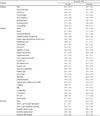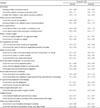1. Korean Educational Development Institute. 2019 Guidelines for afterschool [internet]. Afterschool Portal System;2018. cited 2019 Sep 10. Available from:
https://www.afterschool.go.kr/.
2. Ministry of Education. 2019 Operation guidelines for new semester afterschool. Sejong: Ministry of Education;2018.
3. Kim HW. A suggestion for improvement of after-school. Ministry of Education;2010. 12.
4. Korea Health Promotion Institute. 2016 Annual report. Seoul: Korea Health Promotion Institute;2017.
5. Ministry of Education. Sample data analytics results of physical growth, health screening of students [Internet]. Ministry of Education;2016. cited 2019 Sep 10. Available from:
https:// www.moe.go.kr/main.do.
6. Kim HR, Lee SH, Choi JM, Oh YI. Children's obesity and underweight among low income families in Korea: Status, implications and policy options. Korea Institute for Health and Social Affairs;2011. 12. Report No. 2011-07.
7. Ministry of Education. 2014 School health examination sample survey. Sejong: Ministry of Education;2015.
8. Korea Centers for Disease Control and Prevention. Korea health statistics 2017: Korea National Health and Nutrition Examination Survey [Internet]. Ministry of Health and Welfare;2018. cited 2019 Sep 10. Available from:
https://knhanes.cdc.go.kr/knhanes/index.do.
9. Kim JH, Lee MH, Park OJ, Choi KS. A study on the development of the goals and contents system of healthy dietary education program for after-school care in lower grade in elementary school. Korean J Community Nutr. 2019; 24(1):24–37.
10. Sung EJ. Establishment of roadmap for intervention study of adolescent obesity to prevent and control metabolic disease. Korea Centers for Disease Control & Prevention;2016. 04. Report No. 2015-ER-6402-00.
11. Lee YS, Lim HS, Chang NS, Ahn HS, Kim CI, Kim KN , et al. Nutrition through the life cycle. 4th ed. Paju: Gyomoonsa;2017.
12. Yoo KH. Effects and problems of dining-out behavior on dietary habits. Seoul: National Assembly of Korea;2004.
13. Ministry of Education. 2017 Sample data analytics results of physical growth, health screening of students [Internet]. Ministry of Education;2018. cited 2019 Sep 10. Available from:
https:// www.moe.go.kr/main.do.
14. Yun JS, Lyu ES. Satisfaction and perception of nutrition education by elementary school students. J Korean Soc Food Sci Nutr. 2012; 41(9):1259–1264.
15. Kim HJ. Relationships among nutrient intake status, dietary balance and sugar-containing food intake of elementary school students in Daegu area [master's thesis]. Keimyung University;2010.
16. Cho MY, Lee MJ, Lee YM. A study on utilization and consumption promotion of seafood in elementary school lunch program. Korean J Food Culture. 2003; 18(2):139–150.
17. Kyeon YK. Application of practical nutrition education program for the improvement of dietary habits and attitudes of elementary students [master's thesis]. Seoul National University of Education;2006.








 PDF
PDF ePub
ePub Citation
Citation Print
Print












 XML Download
XML Download